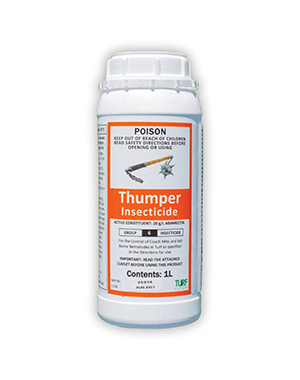How to Control Chafer Grubs in Your Lawn
Chafer Grubs are the larvae of different types of Scarab and Cockchafer Beetles, which live in the soil and feed on plant roots. The most damage is caused by final stage ...


Mites are tiny creatures, in some cases visible only through a magnifying hand lens or microscope.
It’s usually the damage large numbers of Mites cause by piercing and sucking on leaves, stems, flowers and fruit that alerts us to their presence.
If you keep a close eye on what’s happening in your garden, you’ll be more likely to see this damage early and have a better chance of controlling an outbreak.
Left unchecked, Mites breed quickly, and it can just a few days for their population to explode and spread widely.
There are thousands of species of Mites in Australia, but Two Spotted Mites – also known as Spider Mites – are among the most troublesome for gardeners and lawns.
Two Spotted Mites don’t usually cause much damage to grass but can use it as a host before invading flower, fruit and vegetable beds which is where the real trouble happens.
 Damage from Two Spotted Mites appears as tiny yellowish spots on the top of leaves where the bugs have sucked sap from underneath.
Damage from Two Spotted Mites appears as tiny yellowish spots on the top of leaves where the bugs have sucked sap from underneath.
They will attack fruiting plants, ornamentals, vegetables, grasses and can breed in Broadleaf Weeds, especially when conditions are hot and dry.
Two Spotted Mites prefer to feed on young shoots and will move up a plant as new growth becomes available. This can cause distortion of flowers and growing tips and leave plants looking sunburnt or drought affected.
Investigate any plant with curled leaves or showing a web of fine threads or silvering on leaves or fruit.
If you suspect the presence of Two Spotted Mites, hold a piece of white paper under a leaf and tap it. Then look for moving spots on the paper.
You might need to use a magnifying glass to see the adults, which can be up to 0.5mm long, yellowish-green in colour, with eight legs and a large dark spot on each side of the abdomen.
They can change to a reddish-orange colour in cooler conditions.
There are several granular and liquid chemical options for controlling Two Spotted Mites.
They include products containing the active ingredient Chlorantraniliprole, organic options, and products specifically designed for mites, called miticides, that contain the active ingredient Abamectin.
Be aware that miticides are also highly toxic to beneficial insects, such as Ladybugs and Bees, for several days.
Do not graze or feed lawn clippings from treated areas to poultry or animals.

Acelepryn 750ml is an outstanding liquid insecticide with a low environmental impact. It is suitable for use on Zoysia, Kikuyu, Couch and Buffalo grasses.
SHOP NOW
Thumper 1L is a fast-acting insecticide that provides long residual control of Mites and Soil Borne Nematodes in lawns. It is suitable for use on Zoysia, Kikuyu, Couch, Buffalo grasses.
SHOP NOWBest results are achieved if applied as Mite populations begin to build rather than at their peak when they can do a lot of damage.
 Adding a wetter to the mixture can improve the effectiveness of a miticide spray.
Adding a wetter to the mixture can improve the effectiveness of a miticide spray.
Do not apply when it’s unusually hot or a burst of heat is expected within 24 hours of application, rainfall is imminent, or under slow drying conditions.
Wear the appropriate safety gear and use a boom spray, not a backpack or hand gun sprayer, to apply miticide evenly over all leaf areas.
Keep nozzles lower than 50cm above the ground to reduce the risk of spray drift.
Do not use your irrigation or sprinkler system to apply miticide.
Insecticides are absorbed by the plant and consumed by mites feeding on both sides of the leaves.
The mites stop feeding and die within 7-10 days. Residual control in the leaves lasts for several weeks.
Poor lawn maintenance can contribute Mite problems from year to year.
Follow good mowing practices, dethatch and aerate regularly to help keep insects at a minimum.
Lawns mown too short are at greater risk of damage because they are already under stress.
 There are several non-toxic soap-based sprays made from natural vegetable oils that can be used for Two Spotted Mite control.
There are several non-toxic soap-based sprays made from natural vegetable oils that can be used for Two Spotted Mite control.
Apply sprays in the cooler early morning or late evening, and repeat every five to seven days or as needed.
Make sure temperatures are not above 30 degrees Celsius and plants are not under stress.
Pyrethrin sprays and wettable sulphur also offer organic methods of tackling Two Spotted Mites.
Neem Oil extract applied as a foliar spray also is effective. Used properly it is safe for humans and does not target beneficial insects such as Bees, Butterflies and Ladybugs.
Always read the safety directions and instructions on the product label before use.
There’s more information about managing common pests in your lawn here, and you can browse our range of lawncare products from leading brands at myhomeTURF’s online store.
Sign up for our Newsletter to receive your free guide.
